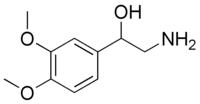
| |

| |
| Names | |
|---|---|
| Preferred IUPAC name
2-Amino-1-(3,4-dimethoxyphenyl)ethan-1-ol | |
| Other names
3,4-Dimethoxy-beta-hydroxyphenethylamine
3,4-Dimethoxy-1-ethyl-(beta-hydroxy)amine | |
| Identifiers | |
3D model (JSmol)
|
|
| ChemSpider | |
PubChem CID
|
|
| UNII | |
CompTox Dashboard (EPA)
|
|
| |
| |
| Properties | |
| C10H15NO3 | |
| Molar mass | 197.234 g·mol−1 |
Except where otherwise noted, data are given for materials in their standard state (at 25 °C [77 °F], 100 kPa).
| |
DME (3,4-dimethoxy-beta-hydroxyphenethylamine) is a lesser-known psychedelic drug. It is the beta-hydroxy derivative of 3,4-dimethoxyphenethylamine. DME was first synthesized by Alexander Shulgin. In his book PiHKAL, the minimum dosage is listed as 115 mg, and the duration unknown. DME produces few to no effects.[1] Very little data exists about the pharmacological properties, metabolism, and toxicity of DME.